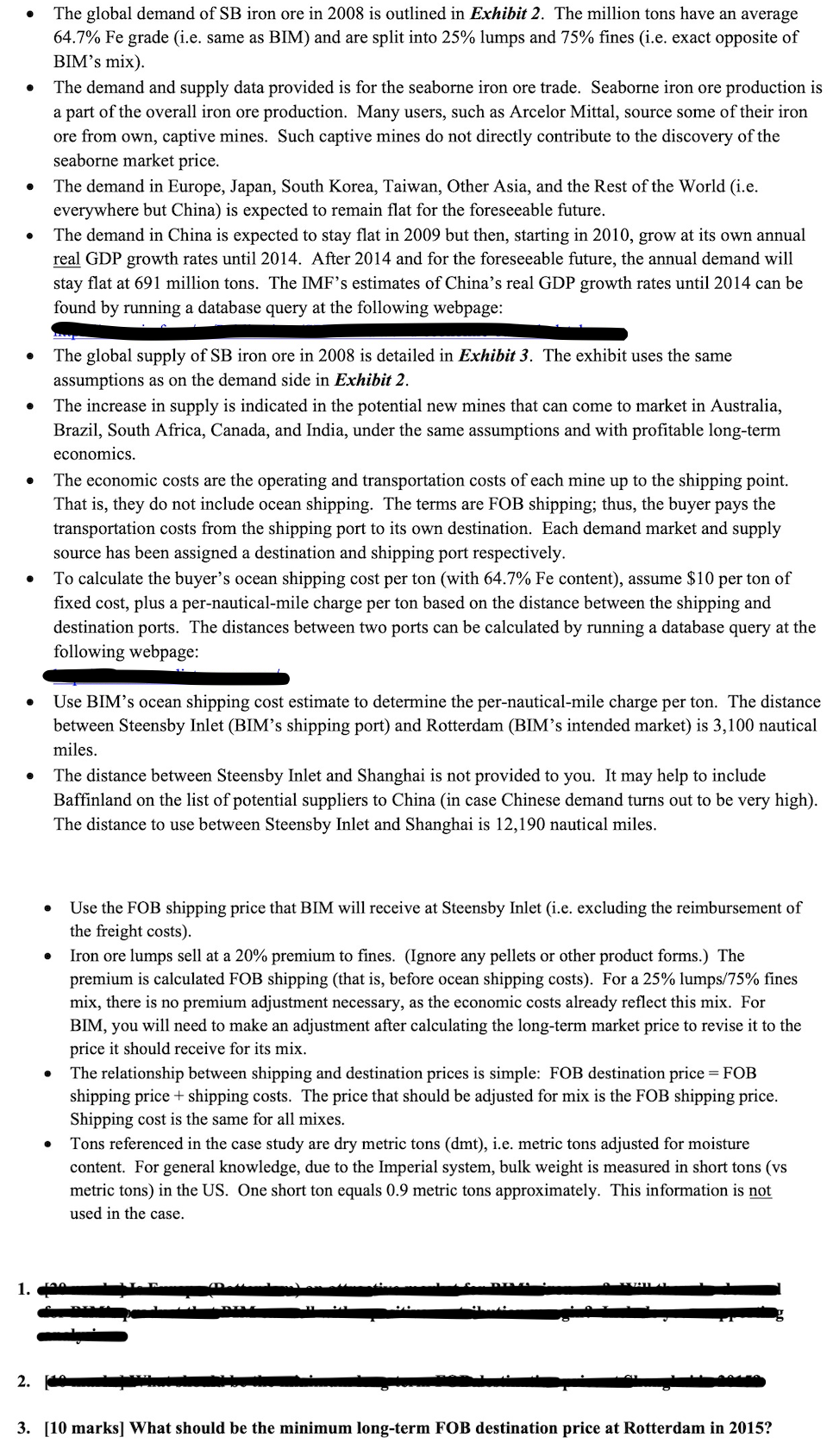
- The global demand of SB iron ore in 2008 is outlined in Exhibit 2. The million tons have an average 64.7%Fe grade (i.e. same as BIM) and are split into 25% lumps and 75% fines (i.e. exact opposite of BIM's mix). - The demand and supply data provided is for the seaborne iron ore trade. Seaborne iron ore production is a part of the overall iron ore production. Many users, such as Arcelor Mittal, source some of their iron ore from own, captive mines. Such captive mines do not directly contribute to the discovery of the seaborne market price. - The demand in Europe, Japan, South Korea, Taiwan, Other Asia, and the Rest of the World (i.e. everywhere but China) is expected to remain flat for the foreseeable future. - The demand in China is expected to stay flat in 2009 but then, starting in 2010, grow at its own annual real GDP growth rates until 2014. After 2014 and for the foreseeable future, the annual demand will stay flat at 691 million tons. The IMF's estimates of China's real GDP growth rates until 2014 can be found by running a database query at the following webpage: - The global supply of SB iron ore in 2008 is detailed in Exhibit 3. The exhibit uses the same assumptions as on the demand side in Exhibit 2. - The increase in supply is indicated in the potential new mines that can come to market in Australia, Brazil, South Africa, Canada, and India, under the same assumptions and with profitable long-term economics. - The economic costs are the operating and transportation costs of each mine up to the shipping point. That is, they do not include ocean shipping. The terms are FOB shipping; thus, the buyer pays the transportation costs from the shipping port to its own destination. Each demand market and supply source has been assigned a destination and shipping port respectively. - To calculate the buyer's ocean shipping cost per ton (with 64.7% Fe content), assume $10 per ton of fixed cost, plus a per-nautical-mile charge per ton based on the distance between the shipping and destination ports. The distances between two ports can be calculated by running a database query at the following webpage: - Use BIM's ocean shipping cost estimate to determine the per-nautical-mile charge per ton. The distance between Steensby Inlet (BIM's shipping port) and Rotterdam (BIM's intended market) is 3,100 nautical miles. - The distance between Steensby Inlet and Shanghai is not provided to you. It may help to include Baffinland on the list of potential suppliers to China (in case Chinese demand turns out to be very high). The distance to use between Steensby Inlet and Shanghai is 12,190 nautical miles. - Use the FOB shipping price that BIM will receive at Steensby Inlet (i.e. excluding the reimbursement of the freight costs). - Iron ore lumps sell at a 20% premium to fines. (Ignore any pellets or other product forms.) The premium is calculated FOB shipping (that is, before ocean shipping costs). For a 25% lumps /75% fines mix, there is no premium adjustment necessary, as the economic costs already reflect this mix. For BIM, you will need to make an adjustment after calculating the long-term market price to revise it to the price it should receive for its mix. - The relationship between shipping and destination prices is simple: FOB destination price =FOB shipping price + shipping costs. The price that should be adjusted for mix is the FOB shipping price. Shipping cost is the same for all mixes. - Tons referenced in the case study are dry metric tons (dmt), i.e. metric tons adjusted for moisture content. For general knowledge, due to the Imperial system, bulk weight is measured in short tons (vs metric tons) in the US. One short ton equals 0.9 metric tons approximately. This information is not used in the case. 1. 2. 3. [10 marks] What should be the minimum long-term FOB destination price at Rotterdam in 2015







